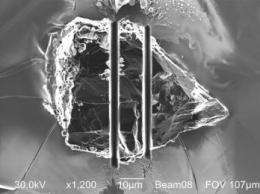February 28, 2012 report
Samples returned from asteroid Itokawa reveal history of violent impacts

(PhysOrg.com) -- In June of 2010, Japanese researchers launched a probe called Hayabusa into space on a mission to study the asteroid Itokawa (25143). It managed to collect dust specimens from the asteroid’s surface which were subsequently (for the first time ever) brought back to Earth when the probe parachuted into the Australian outback. Since that time, the specimens have been studied in every imaginable way resulting in several papers being published in several journals. Now, in a paper published in the Proceedings of the National Academy of Sciences, the research team is reporting on its findings after placing several specimens under an electron microscope.
To study the dust particles more closely the team cut five of the grains into smaller pieces and placed them under an electron microscope. What they found were dust particles that very clearly displayed a violent history. The grains were pitted, or cratered, indicating they had been struck by other particles at speeds high enough to cause them to melt on impact. They also found other particles stuck to the grains that had struck hard enough to embed themselves; to cause such affects, the researchers estimate that the smaller particles must have been traveling at speeds between ten and twenty two thousand miles per hour - particles that were micro to micron sized. In studying the particles that had stuck, the researchers found several that were apparently made of glass.
Because the dust particles were taken from the surface of the asteroid, they believe they represent the low gravity environment that the asteroid would have encountered as it journeyed through space. Thus, the outside layer is made up mostly of ordinary chondrite material.
Itokawa is a 500 meter long asteroid that is believed to be a fragment of a much larger rock, some suggest one as large as 20 kilometers long, and because it has such a low density, many in the research community refer to it as more of a rubble pile than a true asteroid. It was first discovered in 1998 and named for famed Japanese scientist Hideo Itokawa. Hayabusa brought back more than fifteen hundred particle samples.
The team’s findings suggest that rather than existing as static remnants created during the formation of the solar system, as many in the past have assumed, asteroids appear to have undergone almost constant change as they have struck and been struck by other space particles altering their exterior and perhaps their interior as well.
More information: Space environment of an asteroid preserved on micrograins returned by the Hayabusa spacecraft, PNAS, Published online before print February 27, 2012, doi: 10.1073/pnas.1116236109 (OPEN ACCESS ARTICLE)
Abstract
Records of micrometeorite collisions at down to submicron scales were discovered on dust grains recovered from near-Earth asteroid 25143 (Itokawa). Because the grains were sampled from very near the surface of the asteroid, by the Hayabusa spacecraft, their surfaces reflect the low-gravity space environment influencing the physical nature of the asteroid exterior. The space environment was examined by description of grain surfaces and asteroidal scenes were reconstructed. Chemical and O isotope compositions of five lithic grains, with diameters near 50 μm, indicate that the uppermost layer of the rubble-pile-textured Itokawa is largely composed of equilibrated LL-ordinary-chondrite-like material with superimposed effects of collisions. The surfaces of the grains are dominated by fractures, and the fracture planes contain not only sub-μm-sized craters but also a large number of sub-μm- to several-μm-sized adhered particles, some of the latter composed of glass. The size distribution and chemical compositions of the adhered particles, together with the occurrences of the sub-μm-sized craters, suggest formation by hypervelocity collisions of micrometeorites at down to nm scales, a process expected in the physically hostile environment at an asteroid’s surface. We describe impact-related phenomena, ranging in scale from 10-9 to 104 meters, demonstrating the central role played by impact processes in the long-term evolution of planetary bodies. Impact appears to be an important process shaping the exteriors of not only large planetary bodies, such as the moon, but also low-gravity bodies such as asteroids.
Journal information: Proceedings of the National Academy of Sciences
© 2011 PhysOrg.com




















